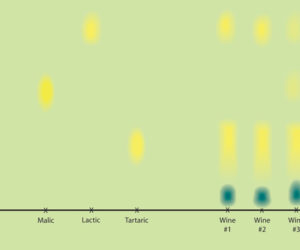 Q
Q
How do I get copper sulfate in accurate diluted food grade form? I would like to treat 5 gallons (19 L) of stinky fruit wine to get rid of the rotten sewer smell.
Michael Seckora
Hillsboro, Oregon
A
Copper sulfate solution is one of those winemaking tools that seems to be tough for home winemakers to lay their hands on. It is often used, as you mention, for the treatment of wines affected by “rotten sewer” or a “rotten egg” smell. I think that it’s difficult to find because, luckily, it’s one of those chemicals that most of us only have to use once in a very long while.
Check with your local winemaking supply shop to see if they stock copper sulfate crystals. One good, reliable source for copper sulfate crystals, as well as 1% and 10% solutions pre-made, is Vinquiry, a wine and wine lab supply house and analytical service provider out of California. They can be contacted at Vinquiry, 7795 Bell Road, Windsor, California 95492 or by phone at (707) 838-6312.
As with any wine additive, it is best to experiment with bench trials first. Copper sulfate — 25.47% of which is copper — is legal in the U.S., as long as residual levels don’t exceed 0.5 ppm as copper. To see if copper sulfate will help the off smell in your wine (as stinky wines aren’t always responsive to this additive), I advise conducting a quick bench trial with a 1% copper sulfate solution as per below:
- Label two wine glasses, one as “control” and one as “copper.”
- Measure about 50 mL of the wine in question into the wine glasses.
- Measure out 1 mL of 1% copper sulfate solution into each “copper” glass.
- Swirl each glass, let them sit for about five minutes, then smell each (do not taste as this is quite a bit of copper for 50 mL of wine).
If the copper glass still has the stinky smell, it goes to follow that copper sulfate will not help out your wine — or it could just be you haven’t added enough. For scientific purposes, it’s worthwhile to double the amount to see if it helps. (Keep in mind that 1 mL of a 1% solution added to 50 mLs wine is way over the legal limit of 0.5 ppm as copper).
If you do find that the 1 mL of 1% copper sulfate solution does help your wine, you can perform further bench trials to hone in on the amounts you should use. Too much copper sulfate added can strip the aromas or slightly change the flavor and mouthfeel profile of wines, so it’s always best to add the minimum amount needed. Experiment by trying various levels of the 1% solution in 50 mL samples of wine. (Be sure to dilute it accurately — it helps to have volumetric pipets or flasks as well as a supply of distilled water.) Once you find the level you like, scale up the small-scale amount used to determine how much solution to add to your volume of wine.
Copper sulfate is one of those additives that, hopefully, not many of us winemakers need to use very often. However, when it’s required, there’s nothing like copper sulfate to take the rotten egg smell out. Order some and be sure to ask for technical literature about hydrogen sulfide (the usual culprit of the rotten egg smell), sulfide detection trials and copper sulfate trials. Of course, prevention is always the best solution to any problem, so take extra care and pay close attention to details in your winemaking before your wine starts smelling like rotten eggs and you will have solved the issue before it arose.
Q
I made 15 gallons (57 L) of wine in my basement and it won’t finish fermenting. Now I am left with a wine that is carbonated, which I do not mind. The problem is that when I store them on their sides, they start to bleed through the corks — two even popped out of the bottle! So the taste I don’t mind, but how do I store these bottles? Will they all eventually just explode? Would it be a good idea to start drinking them sooner as opposed to later? I was thinking of adding a stabilizer in each bottle and then recorking them. Would this work or should I just keep the wine stored upright? Also, I started on 15 more gallons (57 L) of wine in my basement not knowing that this problem would exist. Since then I have wrapped the carboys with blankets hoping that they would retain enough heat for a good fermentation. Is this a good idea or should I move them upstairs?
Warren Rutgers
Kingsville, Ontario
A
Ah, the joys of an incomplete fermentation. I’ll start by answering your last question first. Yes, moving your carboys to a warmer place is a very good idea. I don’t know the average temperature in your basement, but it’s likely that — if your basement is below 55 ºF (13 ºC) — cooler temperatures did contribute to a slow-down and the eventual sticking of your fermentation. Most yeast become sluggish (some can even start shutting down) if their ambient temperature of the wine drops below 55 ºF (13 ºC). It’s a good idea to check with the manufacturer for the specific characteristics of your yeast strain, but most commercial yeast strains are happiest in a 60–80 ºF (16–27 ºC) temperature range.
With regards to your 15 gallons (57 L) of wine that still has residual sugar — the approach you take will depend on how much of an interventionist you want to be. You obviously have some residual sugar or malic acid that is still getting consumed by yeast or lactic acid bacteria. The organism or organisms still living in your wine are producing carbon dioxide gas as they finish out the fermentation in the corked bottles, causing the perceived spritziness in your wine as well as the popping of your corks.
If, as you say, you don’t mind the fizziness and find that standing your bottles up rather than storing them on their sides keeps the corks from popping, go ahead and store them upright. Since this wine seems to be relatively unstable and not meant for long-term aging anyway, I wouldn’t worry about the corks getting dry as they’ll be fine by the time you drink it.
Long story short, it’s best, as we all know, to start with a good, healthy and strong fermentation that will finish itself out. I think that moving your current vintage up into your house to a warmer locale is a good place to start your troubleshooting.






